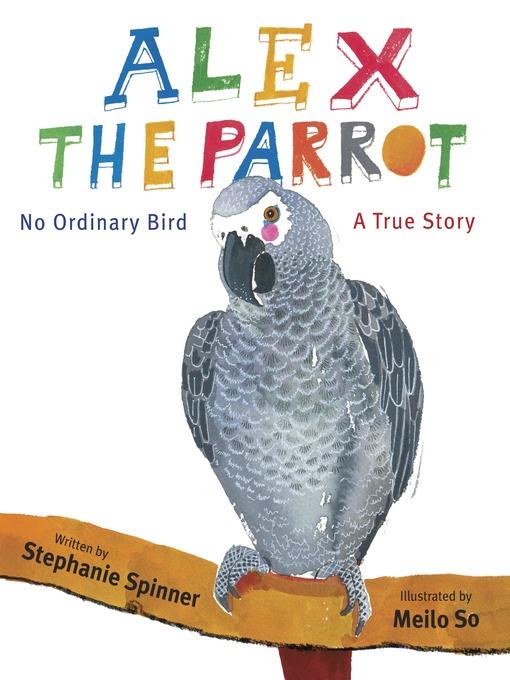
Alex the Parrot
No Ordinary Bird: A True Story
فرمت کتاب
ebook
تاریخ انتشار
2012
Lexile Score
680
Reading Level
2-3
ATOS
4.1
Interest Level
K-3(LG)
نویسنده
Meilo Soشابک
9780307975676
کتاب های مرتبط
- اطلاعات
- نقد و بررسی
- دیدگاه کاربران
نقد و بررسی

Starred review from September 24, 2012
Alex, as adult readers may recall, was indeed no ordinary bird: for 30 years, this African grey parrot, purchased in a pet shop, was the research subject of animal psychologist Irene Pepperberg, who taught Alex how to count and do simple arithmetic; recognize shapes, materials, sizes, and colors; and speak and understand hundreds of words—upending the conventional wisdom about animal intelligence and proving that “birdbrain” could actually be a compliment. Alex died suddenly in 2007 and was mourned worldwide, but his life is well-served by Spinner (Aliens for Breakfast) and especially by So, whose fans will no doubt cheer her having found another bird story (after 2008’s Pale Male) that’s a perfect match for her artistry. Together they dive into the details of Alex and Pepperberg’s work, giving Alex’s larger than-life personality its full due (“He let everybody know what he wanted, pretty much all the time”), and showing, with admirable restraint, how an experiment also became an expression of love and deepest respect. It’s a remarkable story with a sad ending—but it’s a good kind of sad. Ages 8–12.

October 1, 2012
Gr 1-4-In four generously illustrated picture-book chapters, Spinner tells of Irene Pepperberg's studies in animal communication. As a graduate student, Pepperberg purchased an African grey parrot and named it Alex, short for Avian Learning Experiment. He became the subject of her work at Purdue University. Over time, as Alex became less frightened and learned to verbalize, he changed into a bossy show-off. Pepperberg trained him to identify colors, shapes, materials, and numbers. Once Alex acquired a vocabulary, he put words together and demonstrated an unusually high level of intelligence for a bird. When stories about him appeared in the media, he became a star. Sadly Alex passed away in 2007, but the results of Pepperberg's research changed the way people think about birds and influenced pet owners' care of African grey parrots. Spinner adds a note summarizing her own experiences with pets and tucks in a comment about how understanding animals has progressed. This easy-to-comprehend account is not burdened by technical jargon. So's artwork is done in a combination of colored inks, watercolors, gouache, and colored pencil. A realistic-looking Alex appears on many pages. Lots of white space make the images pop. Solidly colored endpapers give the book a tropical feel and add to the quality packaging. Spinner and So's combined talents recount an interesting slice of animal science.-Lynn Vanca, freelance librarian, Akron, OH
Copyright 2012 School Library Journal, LLC Used with permission.

September 15, 2012
Irene Pepperberg's African gray parrot learned to speak and understand English so well he changed both public and scientific beliefs about animal communication and cognition. Named Alex, for Avian Learning EXperiment, the parrot was randomly acquired from a pet shop for graduate student Pepperberg's research. Spinner deftly summarizes the next 30 years of his training, gradual learning and public attention, ending with his untimely death in 2007. The author weaves in information about other talking animals: Clever Hans, the horse who read his trainer's unconscious cues, and the signing apes Washoe and Koko. She concludes with some outcomes of Pepperberg's studies and her current research. But it is Alex's story, told with admiration and acceptance, that is the essence of this appealing title. Organized topically into short chapters, the chronology of his life remains clear. So's illustrations, done with colored ink and pencils, watercolors and gouache, show parrots in the wild and the pet store and, especially, Alex in action. Sometimes his words appear in colorful speech bubbles. These images, set directly on the white pages, above, below or alongside the text, filling an opposing page or bleeding across the fold, emphasize Alex's personality but also add to readers' understanding of the research work. Bird lovers will be charmed. (author's note) (Informational picture book. 5-10)
COPYRIGHT(2012) Kirkus Reviews, ALL RIGHTS RESERVED.

October 1, 2012
Grades 2-5 The bigger the brain, the smarter the creature or so scientists thought until graduate student Irene Pepperberg bought an African Grey parrot from a pet shop. Named Alex, short for Avian Learning Experiment, the bird would defy all expectations by learning to use more than 100 words; perform rudimentary mathematics; and discern shapes, colors, and moreeventually demonstrating the intellectual capacity of a five-year-old child and forever changing the way we think about animal intelligence. Divided into five chapters, Spinner's lengthy text uses an accessible, conversational tone to balance the science with the more personal story of Pepperberg's steadfast determination and the deep animal-human bond that developed between the two. So's superb multimedia illustrations on white backgrounds inject vibrancy and personality and place the focus squarely on the book's magnetic subject. A concluding author's note touches on Spinner's fascination with animal communication, but it does not offer any details on the author's research, Pepperberg's findings or her detractors, or further resources for interested readersof which there will be many.(Reprinted with permission of Booklist, copyright 2012, American Library Association.)

























دیدگاه کاربران